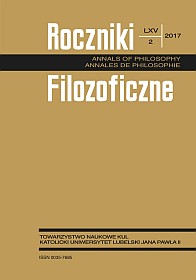Leibniz’s Scientific Collaboration with Adam Kochański, S.J.
Abstract
The exchange of thoughts between Adam Kochański and Leibniz presented in this paper points to a very large spectrum of scientific interests shared by both scientists. The scope of their research included, above all, mathematics, philosophy, linguistics, the construction of a calculating device, a perpetuum mobile, other mechanics, and alchemy. Both men became close to each other through their passion for mathematics in which they searched for a universal method of scientific investigation, a method that would be of use not only in solving typically mathematical puzzles, but would also serve to solve problems in physics and other technical sciences. The ideas they exchanged, in particular those concerning the calculating machine, a perpetuum mobile and the universal cure, the panaceum, indicate a very special aspect of their scientific activity, namely their openness to the technical problems discussed in their time. Both Kochański and Leibniz regarded seriously the practical dimension of human life as it manifested itself in the technical problems that occupied the minds of their contemporaries. They both treated the scientific treatment of these problems as an important area of scientific and technical activity. Kochański, like Leibniz, firmly believed that science should be concerned with practical activity, the attitude captured by one of the principles of his philosophy, Theoria cum praxi. This principle, shared by both learned men, forms one of their principal philosophical ideas.
Adam Kochański and Leibniz were scientists and philosophers living in a time of revolutionary changes in both European philosophy and science; they keenly appreciated the value of new currents in intellectual life, yet they did not lose sight of philosophical tradition, especially the tradition of Aristotelian philosophy, which they both regarded as an important vehicle of truth. Thus, in their style of doing philosophy and science, one finds certain peripatetic traits, for example the acceptance of the Aristotelian conception of philosophy as science.
References
Finster, Reinhard, and Gerd van den Heuvel. Gottfried Wilhelm Leibniz. Hamburg: Rowohlt Taschenbuch Verlag, 1990.
Gut, Przemysław. Leibniz. Myśl filozoficzna w XVII wieku. (Monografie Fundacji na Rzecz Nauki Polskiej. Seria Humanistyczna). Wrocław: Wydawnictwo Uniwersytetu Wrocławskiego, 2004.
Lisiak, Bogdan. Adam Adamandy Kochański (1631-1700). Studium z dziejów filozofii i nauki w Polsce w XVII wieku. (Studia i Materiały do Dziejów Jezuitów Polskich, 15). Kraków: Wydawnictwo WAM, 2005.
Pawlikowska, Zofia. “On the Mathematical Works of Kochański.” Organon 14 (1978): 67–72.
Targosz, Karolina. Jan III Sobieski mecenasem nauk i uczonych. (Monografie z dziejów nauki i techniki, 149). Wrocław, Warszawa, Kraków: Zakład Narodowy im. Ossolińskich, 1991.
Copyright (c) 2017 Roczniki Filozoficzne

This work is licensed under a Creative Commons Attribution-NonCommercial-NoDerivatives 4.0 International License.





